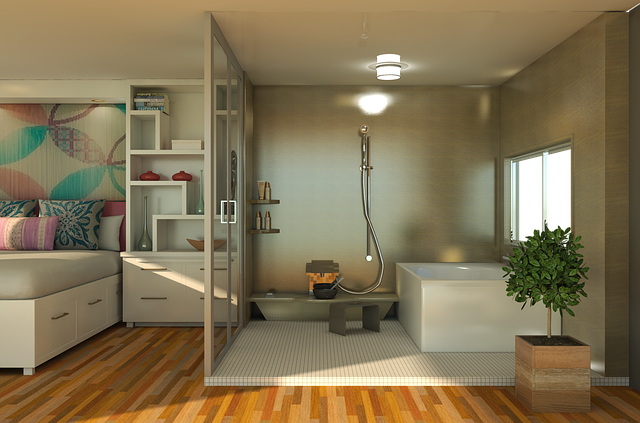Modern design trends prioritize eco-friendliness without compromising aesthetics or functionality by incorporating water-saving fixtures like low-flow showerheads and smart faucets. This approach, emphasizing sustainable materials and technologies, not only reduces environmental impact but also enhances building visual appeal while addressing global water scarcity concerns. As the industry continues to embrace sustainability, innovative solutions like these will drive positive change in both design and ecological preservation.
In today’s world, modern design isn’t just about aesthetics; it’s a powerful tool for promoting sustainability. Combining stylish looks with functional features and eco-conscious practices is no longer a niche concern but a growing trend. This article explores the intersection of design, functionality, and sustainability, highlighting the role of water-saving fixtures in creating beautiful, efficient spaces. We’ll delve into innovative solutions that prove going green can be gorgeous, offering practical tips for integrating sustainable features seamlessly with modern style.
Understanding the Intersection of Design, Functionality, and Sustainability
In the realm of design, functionality, and sustainability, there’s a growing understanding that these three elements are interconnected, each influencing and enhancing the others. Modern design trends often emphasize aesthetics, but today’s consumers are increasingly conscious of environmental impact and practical needs. This shift has led to innovations where stylish designs seamlessly integrate sustainable materials and water-saving fixtures without compromising functionality.
By combining these aspects, designers can create spaces that are visually appealing, efficient, and eco-friendly. For instance, a kitchen with sleek, modern cabinetry might incorporate water-efficient faucets and low-flow showerheads, not only reducing water consumption but also contributing to a more sustainable lifestyle. This intersection of design, functionality, and sustainability ensures that our living and working environments are both beautiful and responsible.
The Role of Water-Saving Fixtures in Modern Interiors
In today’s design landscape, there’s a growing emphasis on creating interiors that are both aesthetically pleasing and environmentally conscious. This shift isn’t just about using eco-friendly materials; it involves integrating water-saving fixtures to achieve a stylish, modern look while promoting sustainability. These fixtures, ranging from low-flow showerheads and water-efficient toilets to smart faucets with motion sensors, play a crucial role in reducing water consumption without compromising on design quality.
Modern interiors often feature sleek lines and clean aesthetics, and water-saving fixtures perfectly align with these trends. From the subtle elegance of sensor-activated taps to the minimalist appeal of low-flow showerheads, these elements can enhance any space while contributing to a significant reduction in household water usage. In light of global water scarcity concerns, embracing water-saving fixtures is not only an environmentally responsible choice but also a stylish one.
Balancing Aesthetics and Environmental Impact
In the pursuit of combining functionality, sustainability, and modern style, designers face a delicate balance: creating visually appealing spaces while minimising environmental impact. This dual goal requires thoughtful consideration to ensure that each design element serves both an aesthetic purpose and contributes to ecological preservation. For instance, incorporating water-saving fixtures not only reduces a building’s carbon footprint but also offers a sleek, contemporary look, aligning with the desired stylish design.
This balance can be achieved by thoughtfully integrating eco-friendly materials and technologies that enhance the space while respecting natural resources. From energy-efficient lighting to water-conserving fixtures like low-flow showerheads and dual-flush toilets, each choice contributes to a harmonious relationship between beautiful interiors and environmental stewardship. By embracing these sustainable practices, modern design can become a catalyst for positive change, proving that form and function can coexist harmoniously with nature.
Innovations in Stylish, Sustainable Design Solutions
The world of design is witnessing a remarkable shift towards sustainability, where environmental consciousness meets aesthetic appeal. Innovations in stylish, sustainable design solutions are pushing boundaries, offering both functionality and visual allure. Architects and designers are now embracing eco-friendly materials, energy-efficient technologies, and creative recycling methods to craft spaces that are not only visually stunning but also kind to the planet.
One prominent trend is the integration of water-saving fixtures and appliances, which not only reduces a building’s environmental footprint but also offers significant cost savings for occupants. From low-flow showerheads and efficient toilets to smart irrigation systems, these innovations ensure luxurious experiences while minimizing water consumption. As design professionals continue to prioritize sustainability, we can expect to see even more creative solutions that merge functionality, aesthetics, and environmental responsibility.
Practical Tips for Integrating Eco-Friendly Features with Modern Style
When aiming to merge functionality, sustainability, and modern aesthetics, several practical tips can guide your design choices. Start by selecting materials that are both eco-friendly and stylish, like reclaimed wood or recycled metals, which offer unique textures and colors while reducing environmental impact. Incorporate energy-efficient lighting fixtures and appliances; LED bulbs and smart thermostats not only lower utility bills but also contribute to a greener home.
Install water-saving fixtures such as low-flow showerheads and aerated faucets to reduce your water footprint without compromising on performance or style. Opt for natural, sustainable fabrics for upholstery and window treatments to enhance the overall look while minimizing the use of synthetic materials. Lastly, consider incorporating smart home technology that allows for automated control of lighting, temperature, and security systems, making your space both modern and energy-efficient.
Modern design doesn’t have to come at the expense of sustainability. By integrating water-saving fixtures and eco-friendly features, we can create stylish spaces that are also kind to our planet. From innovative materials to thoughtful design choices, the possibilities for combining functionality, sustainability, and style are endless. Embracing these trends not only benefits the environment but also offers a unique opportunity to create beautiful, lasting homes and public spaces. So, let’s continue to push boundaries, challenge conventions, and usher in a new era of design that is both aesthetically pleasing and ecologically responsible.
